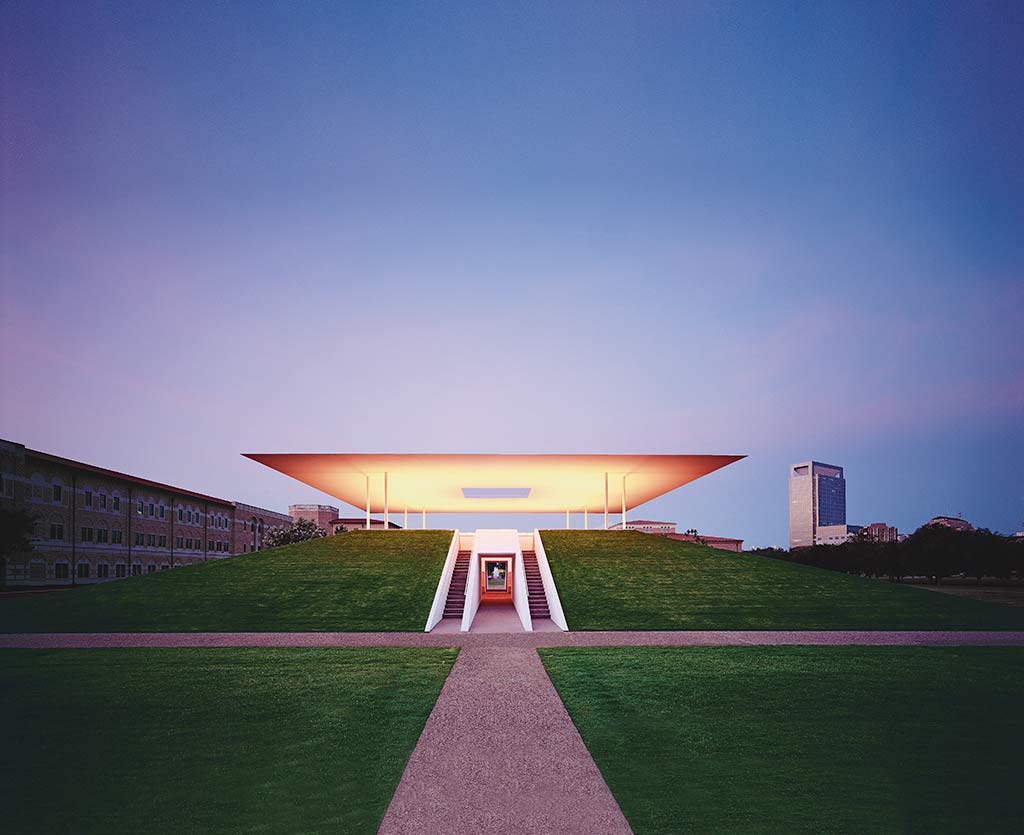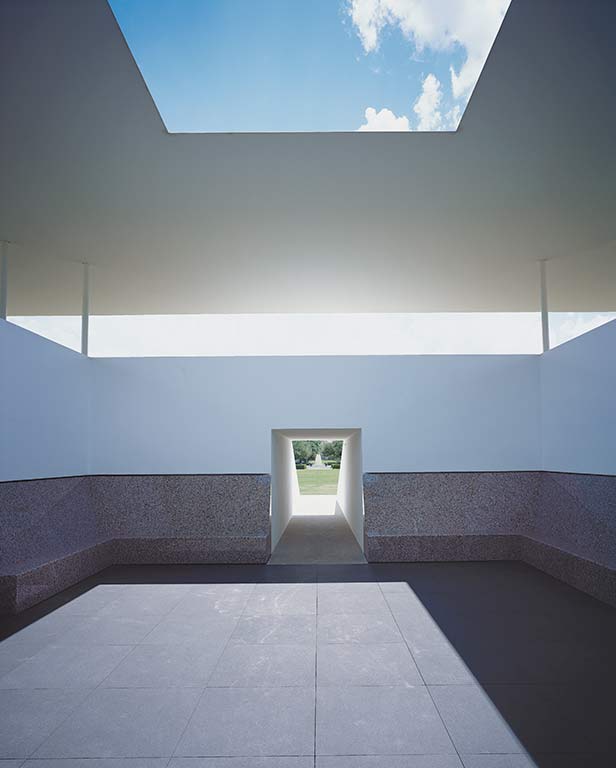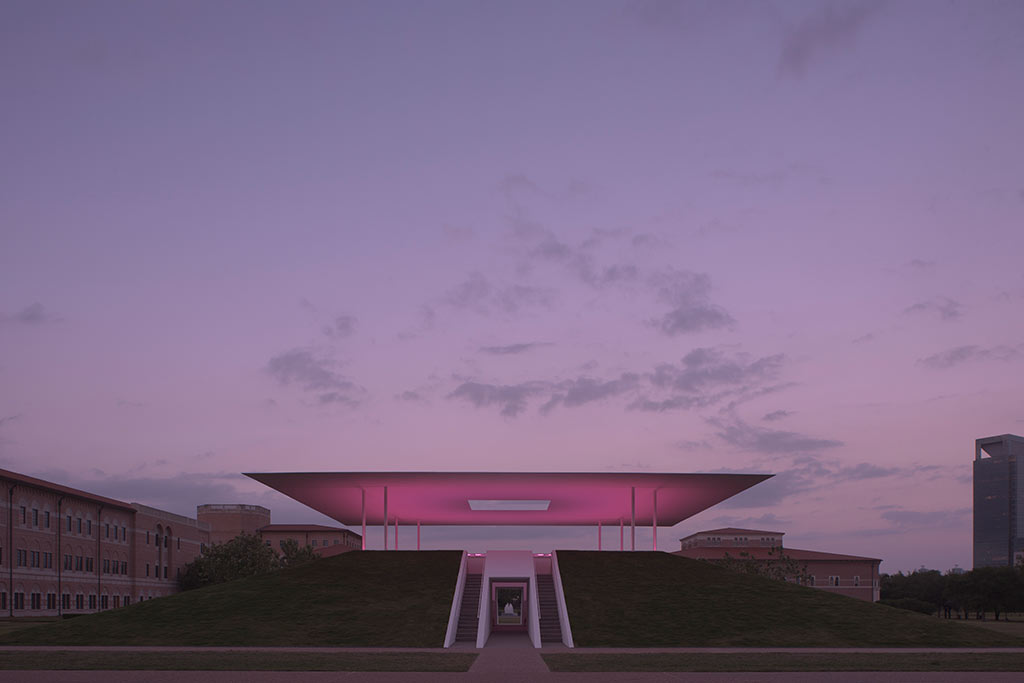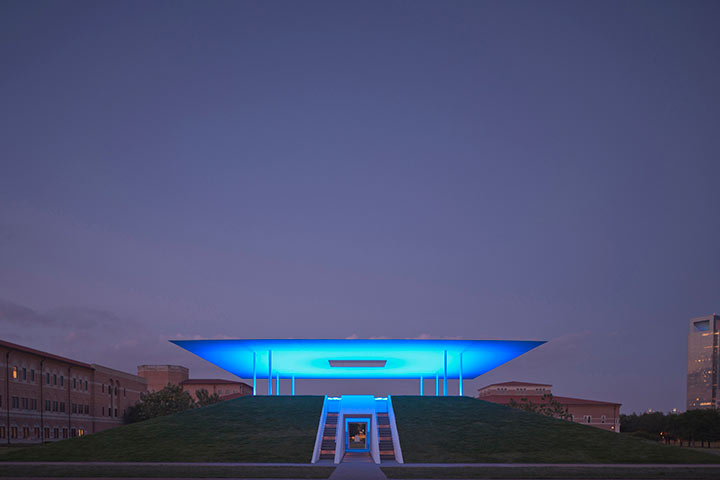A Sky Full of Thoughts
Artist James Turrell’s ‘Twilight Epiphany Skyspace’ brings together the many nuances of architecture, time, space, light and music in a profound experience that blurs boundaries and lets one roam free within their own minds
Vani Sriranganayaki
Is the earth really not flat? I remember those cross-section diagrams of the earth’s core in school books – those were always spherical. So, if the earth is spherical, but we are all perpendicular to it, are we standing upright like pins pinned on a pin cushion? How does that work? I didn’t pay much attention in science class, and I am not that curious enough to Google it now, but these are just some of the very random thoughts that float through my head any time a patch of sky catches my attention and holds it for an embarrassingly long time. Of course, when teachers in school asked, ‘What was so interesting outside the window’, I couldn’t tell them this – but there is something about that moment when you look up at the sky and realise that there in its vastness, every mundane and absurd thought in your head makes complete sense – it is genuinely very interesting! After all, some of history’s most prolific creative minds have often turned to the heavens for inspiration. But in all their journeys across the sky, from when Van Gogh and Munch painted their Starry Night(s) to when Steinbeck penned his ‘torn cloud, like a bloody rag’, the sky, in all its fleeting and ever-changing glory has remained seemingly close, yet just out of reach. That was until James Turrell, the American artist famous for his works on light and space, encased the ethereal within a built form and gave the movement of time and space a sense of physicality – one that can be seen, heard and felt.

James Turrell, ‘Twilight Epiphany Skyspace’. Photograph by Florian Holzherr. Image Courtesy of Rice University Public Art.
Turrell’s 2012 work, titled the Twilight Epiphany Skyspace was architecturally devised by Thomas Phifer and Partners at the Rice University campus in Texas as part of the university’s Centennial Pavilion. It is essentially a 118-foot-square earthwork with grass-bermed walls surrounding a bench-lined atrium forming an abstract pyramidal sculpture. Its highlight, a punctured canopy with a 14-foot-square skylight, is the signature element of Turrell’s ‘Skyspace’ works (this, by the way, was his 73rd!). Twilight Epiphany Skyspace was designed to interact with both the rising and setting Texan sun as a sequence of programmed LED lights dance across the structure’s ceiling in sync with the particular moments of light which occur with earth’s movement across space.

James Turrell, ‘Twilight Epiphany Skyspace’. Photograph by Florian Holzherr. Image Courtesy of Rice University Public Art.
The morning light show starts forty minutes before sunrise and the evening display starts just as the sun begins its slow descent. Twilight Epiphany joins in on the natural movement of light. Its ceiling comes alive with different colours – a pinkish glow mimicking the break of dawn, fiery golden orange as the sun stands on the horizon or iridescent blue as dusk sets in. From the outside, the light shows are, of course, phenomenal; but the best seats in the house, literally, are those inside where the movements in the sky are framed by the skylight and juxtaposed with the shifting shades on the ceiling. With viewing areas built into both the upper and lower segments of the structure, both offering unique perspectives through the square cut-out, the work offers a rather profound experience that is hard to describe, but Molly Hipp Hubbard, Rice University’s Art Director, tried her best, when she said, ‘You are captured with the light sequence that the artist has created, that coordinates with the actual arc of the sun! There’s a lot of power in that. The fact that you are inside a space, and that you are experiencing the art – there are so many different colours that you are seeing – you are looking through an aperture in the roof to basically infinity – there is a lot of freedom in that. It lets one’s imagination go’.

James Turrell, ‘Twilight Epiphany Skyspace’. Photograph by Paul Hester. Image Courtesy of Rice University Public Art.
Under any other circumstance, the calculated play of the lights alone would have been enough to make the project extraordinary – but Turrell, with Twilight Epiphany, went a step further by incorporating music within the experience. Acoustically engineered with invisibly embedded audio speakers, the structure also plays host to musical performances. The light shows are accompanied by site-specific pieces of music composed by students of the nearby Shepherd School of Music – making the entire experience an experiment of constructed light, sound and space.
Architecturally, Twilight Epiphany’s most enticing gesture is its vanishing, razor-fine edges deployed both around the skylight and the outer circumference of the entire canopy. With that one very simple act, the work seemingly transforms all of the sky into a skylight and shelters its entire expanse – all in a surprising turn on public and private, ethereal and tangible, high art and grounded, built realities. There is so much meaning and purpose embedded in its walls that the true character of the work and Turrell’s thought and intent behind it all shine right through, making it the perfect vantage point to view the beauty of the natural world, the temporality of time and our precious existence in it all.

James Turrell, ‘Twilight Epiphany Skyspace’. Photograph by Paul Hester. Image Courtesy of Rice University Public Art.
Inspired by the work, and in a surprise side effect of the lockdown, I wrote this piece away from my usual desk, under my own little skyspace – a doorway leading to terrace of my apartment. The experience probably wasn’t as profound as the one Twilight Epiphany promises, but it definitely was unique and interesting. And sure enough, it led to a few choice epiphanies of my own – like, for instance, is the earth really not flat?
Share